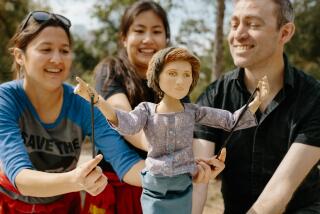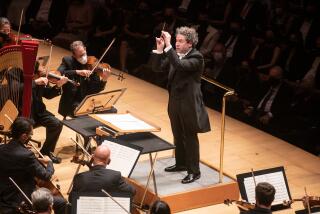Review: David Lang, Michael Gordon and So Percussion toy with minds

Under the green umbrellas at Walt Disney Concert Hall on Tuesday night, the stage was set for industry. Steel pipes, 2-by-4s and other pieces of wood were arrayed in a variety of lengths. Teacups were on hand, as if for break time. Drums too were part of the operation, good for urging on workers’ momentum.
The first of this season’s Los Angeles Philharmonic Green Umbrella new music series was devoted to two big percussion pieces: David Lang’s “the so-called laws of nature” and Michael Gordon’s “Timber.” So Percussion, having wonderfully premiered Lang’s percussion concerto “man made” last week with the L.A. Philharmonic, was the guest ensemble.
The idea was evidently not just a carry-over from last week but also from the orchestra’s Minimalist Jukebox festival last spring; that included works from both Lang and Gordon. The idea may have also been to toy with, and to mess with, listeners’ minds. Lang’s whimsical piece did the delightful toying. Gordon’s hourlong bang-athon on six hardwood 2-by-4s managed the percussive messing with perception.
That Lang and Gordon have a flare for percussion or industry is not news. They are the founders, along with Julia Wolfe, of Bang on a Can, which began as a do-it-yourself festival of new music in New York 27 years ago and now includes annual marathon concerts, an ensemble, a commissioning program, a school, a publishing outfit and a record label. And, thanks to Lang’s “the little match girl passion,” a Pulitzer Prize.
The title of Lang’s “the so-called laws of nature,” which So Percussion commissioned in 2001 shortly after the ensemble was founded by four Yale graduate students, comes from Austrian philosopher Ludwig Wittgenstein’s notion that natural law may tell you how but not why. Lang sets up rhythmic and melodic processes with natural or household materials and then lets them run their course, with slight but telling alterations. You think you know where you are going, but the smallest blip can change everything. You may get back on track. Then again, you may wind up heaven knows where.
There are three sections with mostly the same music. Much of the time the percussionists play in unison and on the same instruments. In the first, that is on seven wood blocks. The second is on the pipes and traditional drums. The third uses the teacups along with flowerpots, wood blocks, bells and a guiro. Some instruments are specifically tuned; others are left up to the musicians’ own devices. Everything is hit mainly with mallets.
The rhythms are intricate yet imply a flowing beat and a process of going from one thing to the next. The effect is one of flowering, of growth from singularity and complex multiplicity. Lang may not honor natural law, but he does like symmetry. Wittgenstein’s mysticism is not in the materials but the mathematics.
Errors matter. Subtle mistuning between the different wood blocks or pipes is what creates the surprising sonic blossoms. It is as if every time you step outside you are in a new, just slightly altered environment. The ceramics at the end, along with a couple of clever turns of phrase, are playful sounds of paradise.
Gordon’s marvels are more challenging. “Timber” is for six percussionists. Joseph Pereira and James Babor from the L.A. Phil joined So’s Eric Beach, Josh Quillen, Adam Sliwinski and Jason Treuting, each with his own amplified 2-by-4. This was guys’ night in the drum circle.
The sounds that come out of a chunk of raw hardwood are plentiful. Loudspeakers caught their alluring overtones, high frequencies that swirl around in space with what seems like a life of their own.
The piece is communal. A player starts the vibration going and others follow around the circle, with the process speeding up and clouds of overtones twining with ever-greater impetus. This too is a new look at the laws of nature. Gordon’s concept of energy picks a bone with Einstein’s famous equation, where e equals mass multiplied by the square of the speed of light. For the composer, e plus motion equals emotion.
The fascination with the harmonics lasts only so long. After a while, you take them granted. The incessant drumming ultimately gets to you. People started to drift out of the hall — hipsters with interesting clothes and hair led the exodus. But most stayed and endured the onslaught, which during the second half-hour put many not in a communal but a personal space. It was hard to always pay attention and not just drift.
Leaving Disney, I felt unsteady, as evidently did others, some of whom ignored traffic signals and stepped incautiously in front of cars on Grand Avenue.
“Timber” is music as a powerful drug. So Percussion and its L.A. Phil friends administered it astonishingly.
Follow me on Twitter: @markswed
More to Read
The biggest entertainment stories
Get our big stories about Hollywood, film, television, music, arts, culture and more right in your inbox as soon as they publish.
You may occasionally receive promotional content from the Los Angeles Times.







